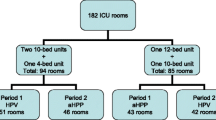Abstract
Non-manual techniques for terminal disinfection of hospital rooms have gained increasing interest in recent years as means to reduce transmission of multidrug-resistant organisms (MDROs). A prospective crossover study by Blazejewski and colleagues in five ICUs of a French academic hospital with a high prevalence of MDRO carriers showed that two different hydrogen peroxide (H2O2)-based non-touch disinfection techniques reduced environmental contamination with MDROs after routine cleaning. This study provides further evidence of the ‘in use’ bioburden reduction offered by these techniques. Before H2O2-based non-touch disinfection can be recommended for routine clinical use outside specific outbreak situations, further studies need to show whether the environmental contamination reduction provided by these techniques is clinically relevant and results in reduced cross-infections with MDROs.
Similar content being viewed by others
Abbreviations
- ESBL-E:
-
Extended spectrum β-lactamase Enterobacteriaceae
- H2O2 :
-
Hydrogen peroxide
- MDRO:
-
Multidrug-resistant organism
- MRSA:
-
Methicillin-resistant Staphylococcus aureus
References
Blazejewski C, Wallet F, Rouze A, Le Guern R, Ponthieux S, Salleron J, et al. Efficiency of hydrogen peroxide in improving disinfection of ICU rooms. Crit Care. 2015;19:30.
Wolf I, Bergervoet PW, Sebens FW, van den Oever HL, Savelkoul PH, van der Zwet WC. The sink as a correctable source of extended-spectrum beta-lactamase contamination for patients in the intensive care unit. J Hosp Infect. 2014;87:126–30.
Freeman JT, Nimmo J, Gregory E, Tiong A, De Almeida M, McAuliffe GN, et al. Predictors of hospital surface contamination with Extended-spectrum beta-lactamase-producing Escherichia coli and Klebsiella pneumoniae: patient and organism factors. Antimicrob Resist Infect Control. 2014;3:5.
Landelle C, Pagani L, Harbarth S. Is patient isolation the single most important measure to prevent the spread of multidrug-resistant pathogens? Virulence. 2013;4:163–71.
Chemaly RF, Simmons S, Dale C Jr, Ghantoji SS, Rodriguez M, Gubb J, et al. The role of the healthcare environment in the spread of multidrug-resistant organisms: update on current best practices for containment. Ther Adv Infect Dis. 2014;2:79–90.
Weber DJ, Anderson D, Rutala WA. The role of the surface environment in healthcare-associated infections. Curr Opin Infect Dis. 2013;26:338–44.
Havill NL, Moore BA, Boyce JM. Comparison of the microbiological efficacy of hydrogen peroxide vapor and ultraviolet light processes for room decontamination. Infect Control Hosp Epidemiol. 2012;33:507–12.
McDonald LC, Arduino M. Editorial commentary: climbing the evidentiary hierarchy for environmental infection control. Clin Infect Dis. 2013;56:36–9.
Passaretti CL, Otter JA, Reich NG, Myers J, Shepard J, Ross T, et al. An evaluation of environmental decontamination with hydrogen peroxide vapor for reducing the risk of patient acquisition of multidrug-resistant organisms. Clin Infect Dis. 2013;56:27–35.
Harbarth S, Maiwald M, Dancer SJ. The environment and healthcare-acquired infections: why accurate reporting and evaluation of biological plausibility are important. Infect Control Hosp Epidemiol. 2013;34:996–7.
Harbarth S. Hospital-based environmental hygiene: priorities for research. Healthcare Infection. 2013;18:49–50.
Acknowledgments
BDH is partially supported by the European Commission (FP7-HEALTH-2011-R-GNOSIS contract 282512).
Author information
Authors and Affiliations
Corresponding author
Additional information
Competing interests
SH has received investigator-initiated research grants funded by Pfizer (New York, NY, USA) and B. Braun (Melsungen, Germany) and is a member of the advisory boards of Destiny Pharma (Brighton, UK), bioMérieux (Marcy l’Etoile, France), Novartis (Basel, Switzerland), and DaVolterra (Paris, France). BDH declares that he has no competing interests.
Authors’ contributions
BDH wrote the first draft of the commentary, and SH revised the manuscript. Both authors read and approved the final manuscript.
See related research by Blazejewski et al., http://ccforum.com/content/19/1/30
Rights and permissions
About this article
Cite this article
Huttner, B.D., Harbarth, S. Hydrogen peroxide room disinfection – ready for prime time?. Crit Care 19, 216 (2015). https://doi.org/10.1186/s13054-015-0915-8
Published:
DOI: https://doi.org/10.1186/s13054-015-0915-8




